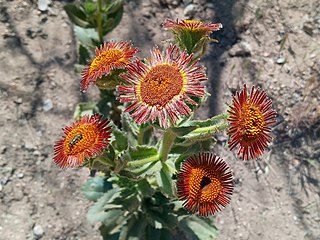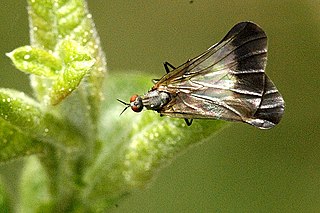
Empididae is a family of flies with over 3,000 described species occurring worldwide in all the biogeographic realms but the majority are found in the Holarctic. They are mainly predatory flies like most of their relatives in the Empidoidea, and exhibit a wide range of forms but are generally small to medium-sized, non-metallic and rather bristly.
Utricularia heterochroma is a very small, possibly perennial, rheophytic carnivorous plant that belongs to the genus Utricularia. U. heterochroma is endemic to Venezuela, where it is known from the type location at Ptari-tepui, two collections from Toronó-tepui, one collection from Apacará-tepui, one collection from Serrania Guanay, and several collections from the Chimantá Massif. It grows as a rheophyte on wet sandstone cliffs near waterfalls among mosses at altitudes from 1,760 m (5,774 ft) to 2,450 m (8,038 ft). It was originally described and published by Julian Alfred Steyermark in 1953.

Hulsea heterochroma, commonly known as redray alpinegold, is a species of flowering plant in the family Asteraceae.
Chylismia heterochroma is a species of evening primrose known by the common name Shockley's evening primrose. It is native to the desert slopes and woodland of eastern California and Nevada. It is a hairy, glandular annual herb growing a spindly stem up to a meter tall. There is a thick basal rosette of leaves which are mostly oval in shape and several centimeters in length, and generally no leaves higher up the stem. The inflorescence produces several small flowers with four oval petals just a few millimeters long and lavender in color with yellow-tinted bases. The fruit is a club-shaped capsule roughly a centimeter long.

Rhamphomyia is a genus of dance flies, in the fly family Empididae.
Rhamphomyia nasoni is a species of dance flies.
Rhamphomyia sudigeronis is a species of dance flies.
Rhamphomyia brevis is a species of dance flies.
Rhamphomyia nana is a species of dance flies.
Rhamphomyia anthracina is a species of dance flies, in the fly family Empididae. It is included in the subgenus Rhamphomyia.
Rhamphomyia bipila is a species of dance flies, in the fly family Empididae. It is include in the subgenus Amydroneura of the genus Rhamphomyia.
Rhamphomyia cervi is a species of dance flies, in the fly family Empididae. It is included in the subgenus Lundstroemiella.
Rhamphomyia cimrmani is a species of dance flies, in the fly family Empididae. It is included in the subgenus Lundstroemiella.
Rhamphomyia speighti is a species of dance flies, in the fly family Empididae. It is included in the subgenus Lundstroemiella.
Rhamphomyia strobli is a species of dance flies, in the fly family Empididae. It is included in the subgenus Lundstroemiella.
Rhamphomyia siebecki is a species of dance flies, in the fly family Empididae. It is included in the subgenus Rhamphomyia.
Rhamphomyia micans is a species of dance flies, in the fly family Empididae. It is included in the subgenus Rhamphomyia.
Rhamphomyia albissima is a species of dance fly in the family Empididae. It is in the subgenus Rhamphomyia (Pararhamphomyia).


